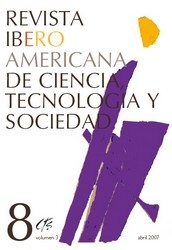De la demostración experta al diálogo participativo
DOI:
https://doi.org/10.52712/issn.1850-0013-947Palabras clave:
ciencia, políticas, regulación, asuntos medioambietalesResumen
Este artículo analiza el papel de la ciencia en el desarrollo e implementación de políticas. Particularmente se presentan y discuten varios modelos conceptuales (principalmente el modelo moderno) que describen la relación e interfaces entre la ciencia y las políticas de regulación de asuntos medioambientales. A su vez, teniendo en cuenta que estos modelos presentan asunciones subyacentes, puntos fuertes y limitaciones, y que ninguno de ellos ofrece una solución universal, el autor se propone articular nuevas alternativas en base a la reformulación de dichos modelos.
Descargas
Citas
BECK, U. (1992): Risk Society: Towards a new modernity, Sage, London.
BUSH, V. (1945): Science -The Endless Frontier, A Report to the President by Vannevar Bush, Director of the Office of Scientific Research and Development, July 1945 (United States Government Printing Office, Washington: 1945), http://www.nsf.gov/od/lpa/nsf50/vbush1945.htm
CBD (1992): “Cartagena Protocol on Biosafety”. Disponible en: http//www.biodiv.org/biosafe/protocol
DE MARCHI, B. (2003): “Public participation and risk governance”, Science and Public Policy, Nº30, 3, June 171-176.
EU (2002): “Communication from the Communities on the collection and use of expertise by the commission: principle and guidelines” (COM 2002:713), Brussels.
EU (2001): “Communication from the Commission on the precautionary principle” (COM 2000:1), Brussels.
EU (2001): “Directive 2001/18/EC of the European Parliament and of the Council on the deliberate release into the environment of genetically modified organisms and repealing”, Council Directive 90/220/EEC, Brussels.
FISHER, R.A. (1951): The Design of Experiments, 6th edition, Oliver & Boyd, Edinburgh.
FUNTOWICZ, S.O. (2006): “Why Knowledge Assessment?”, S. Vaz , A. Pereira (eds): Interfaces between Science and Society, EC Joint Research Centre, (en prensa).
FUNTOWICZ, S.O., RAVETZ, J.R. (1993): “Science for the post normal age”, Futures 25:739-755.
FUNTOWICZ, S.O., RAVETZ, J.R. (1990): “Uncertainty and Quality in Science for Policy”, Kluwer, Dordrecht, 7-16.
GIGERENZER, G. (2004): “Mindless Statistics”, The Journal of Socio-Economics, 33: 587-606.
LASH, S., SZERSZYNSKI, WYNNE, B [ed.] (1996): Risk, Environment & Modernity -Towards a New Ecology, TCS Sage, London.
LATOUR, Bruno (1993): We have never been modern, Harvard University Press, Cambridge Mass., USA.
LOSEY, J.E., RAYOR, L.S., CARTER, M.E. (1999): “Transgenic pollen harm monarch larvae”, Nature, 399:214
LYOTARD, J.F. (1984): “The Postmodern Condition: A Report on Knowledge”, Bennington G & Massumi B. Foreword by Jameson F. Minneapolis: University of Minnesota Press & Manchester: University of Manchester Press.
MARRIS, C., WYNNE, B., SIMMONS, P., WELDON, S. (2001): “Public perceptions of agricultural biotechnologies in Europe”, Final report of the PABE research project, Lancaster, UK: University of Lancaster.
NOWOTNY, H, SCOTT, P., GIBBONS, M. (2001): Re-thinking science: knowledge and the public in an age of uncertainty, Cambridge, Polity Press.
QUIST, D., CHAPELA, I.H. (2001): “Transgenic DNA introgressed into traditional maize landraces in Oaxaca, Mexico”, Nature, 414:541-543.
REES, M. (2003): Our Final Hour, Basic Books.
SCIENTIFIC COMMITTEE ON PLANTS (1999): “Opinion of the Scientific Committee on the Invocation of Austria of Article 16 (‘safeguard’ clause) of Council Directive 90/220/EC with respect to theplacing on the market of the Monsanto genetically modified maize (MON810) expressing the Bt cryia(b) gene, notification”, C/F/95/12/02.
STRAND, R. (2002): “Complexity, Ideology and Governance”, Emergence, 4:164-183.
STRAND, R. (2001): “The role of risk assessment in the governance of genetically modified organisms in agriculture”, Journal of Hazardous Materials, 86:187-204.
WEINBERG, A. (1972): “Science and tran-science”, Minerva, 10:209-222
WYNNE, B. (1992): “Uncertainty and environmental learning: reconcieving science and policy in the preventive paradigm”, Global Environmental Change, 2:111-127.
Descargas
Publicado
Cómo citar
Número
Sección
Licencia
Derechos de autor 2025 CC Attribution 4.0

Esta obra está bajo una licencia internacional Creative Commons Atribución 4.0.
Todos los números de CTS y sus artículos individuales están bajo una licencia CC-BY.
Desde 2007, CTS proporciona un acceso libre, abierto y gratuito a todos sus contenidos, incluidos el archivo completo de su edición cuatrimestral y los diferentes productos presentados en su plataforma electrónica. Esta decisión se sustenta en la creencia de que ofrecer un acceso libre a los materiales publicados ayuda a un mayor y mejor intercambio del conocimiento.
A su vez, para el caso de su edición cuatrimestral, la revista permite a los repositorios institucionales y temáticos, así como también a las web personales, el auto-archivo de los artículos en su versión post-print o versión editorial, inmediatamente después de la publicación de la versión definitiva de cada número y bajo la condición de que se incorpore al auto-archivo un enlace a la fuente original.











